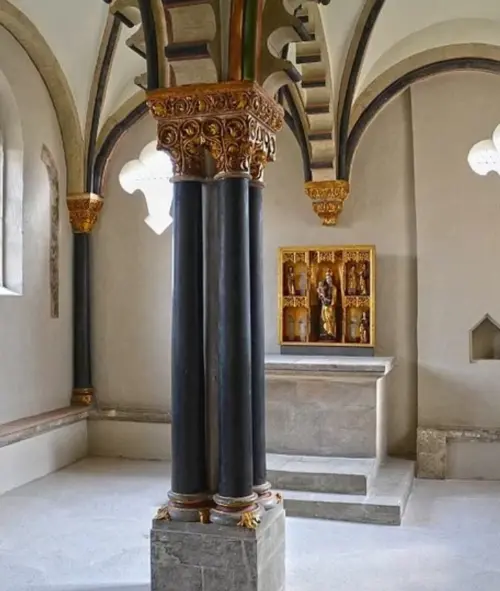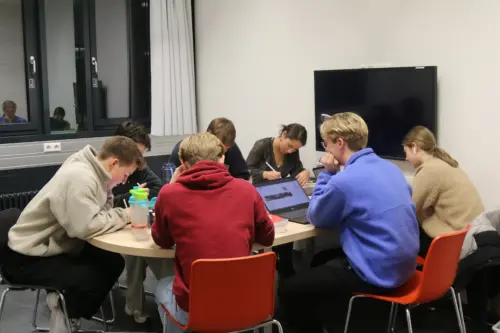Kloster Vessra
Henneberg Museum Monastery Veßra
Monastery History
Only ten years after the foundation of the Premonstratensian Order in 1121 by St. Norbert of Xanten, Gotebold II, Count of Henneberg, together with his wife Liutgard, founded a branch of this young order in the village of Veßra at the foothills of the Thuringian Forest. Founded as a double monastery for women and men, the choir women moved to the nearby Trostadt monastery after a fire in 1177, but remained connected to the men’s monastery through their provost, who was provided by the community of canons.
Situated in a strategically favorable position between the ancestral seat of the counts near Meiningen and their still largely unsettled possessions in the Thuringian Forest, the monastery was to fulfill several functions: The densely forested areas of the surrounding region had to be cultivated and made usable as a settlement area. Pastoral care and the care of the sick in the domain of the counts had to be ensured. A central institution for the training of officials and servants was to be established. Material provisions were to be created for the children of influential families in the region. Last but not least, the founding family wanted to secure a place in heaven. At their final resting place, the Henneberg Chapel, the deceased members of the family were to benefit from the perpetual prayers of the monastery residents.
Thus, until the Reformation, the house monastery of Veßra formed one of the political, economic and cultural centers of the Henneberg region. In the course of the Reformation, the monastery was abandoned in 1544, but the canons continued to be tolerated until the last abbot died in 1573. Evidence of the monastery period includes the ruins of the monastery church, the former burial chapel of the count’s family with the late medieval wall paintings and the Romanesque wooden crucifix, and the south chapel with two astronomical sunlight openings.
Many of the buildings have been altered and changed in the course of the subsequent agricultural use of the site. They, too, are stone witnesses of the eventful history of the post-monastic period.
Henneberg Museum at Veßra Monastery
The former Premonstratensian canons’ monastery of Veßra is now a museum³ [to the power of three]: it combines the medieval monastery complex with half-timbered architecture of the region and technology(s) of agriculture in days gone by. The open-air museum is located on the six-hectare site, which is still completely surrounded by the old monastery wall. The listed complex of Romanesque and Gothic monastery buildings as well as the farm buildings of the domain, which have been built since the 16th century, bear witness to the history of the Henneberger Land as well as the cultural history of southern Thuringia.
Changing special exhibitions on cultural-historical topics and art exhibitions extend the range of over 30 individual exhibitions. The unique combination of history and culture as well as nature and technology makes an unforgettable visit to the museum possible for the whole family. Especially in the summer months, the museum area is the venue for a variety of events. With its colorful markets and demonstrations of traditional crafts, with concerts, theater performances or open-air cinema, the museum offers special experiences in a historical ambience for young and old.
Half-timbered ensemble
In addition to the monastery buildings, an ensemble of half-timbered houses from the region has been built since 1978. The ensemble of the converted half-timbered houses reflects the diversity of the Henneberg-Franconian half-timbered architecture. In the simple and representative residential buildings, visitors can experience the village way of life and work of past generations. A special concern is also the presentation of traditional rural crafts. The exhibition area includes an original blacksmith’s shop, two bakehouses and a water mill. The ensemble is complemented by buildings used by the community, such as the brewery, the cemetery chapel and the community hall.
ExperienceAgriculture
The 5000 m² exhibition area “Experience Agriculture” illustrates the change from small-scale farming to agricultural production cooperatives (LPG). A wide variety of exhibits showcase historical implements from various centuries as well as large harvesting equipment such as tractors and combine harvesters. Some of the technical rarities are set in motion at museum festivals and historical work processes such as threshing grain with threshing machines and horse-drawn harvesters are demonstrated.
The gardens designed according to historical models, such as the monastery garden, the cottage garden and the kitchen garden, present native wild and cultivated plants and invite visitors to linger. The reconstructed hydroelectric plant is more than just a technical monument – it is fully functional and supplies the museum with electricity.
Source: Henneberg Museum Kloster Veßra











